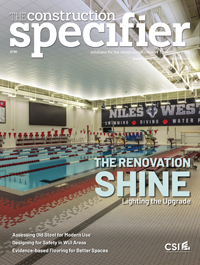Bridging form and function with modern rainscreens
Rainscreen cladding options
There are many options for rainscreen cladding, and the individual performance of each material in this role varies. It is important to classify materials into two separate groups as it relates to how they handle moisture—hydroscopic
and hydrophobic.
Some building materials capture water molecules from the surrounding air and collect them on the surfaces of their inner structures in what is known as an absorbed state. Hydroscopic materials absorb water. Some traditional building materials such as wood, concrete, brick, and plaster are hydroscopic. Hydrophobic materials repel water. Examples include glass, metals, and plastics, including wood-plastic composites.
Materials with less vulnerability to water are gaining popularity among construction teams looking for high-performing, aesthetically pleasing, and sustainable products. This category includes metal cladding options like galvanized steel, aluminum, and copper, which are recognized for their ease
of maintenance. Another compelling option is wood-composite cladding. Designed to emulate real wood, composite cladding is resistant to impact, freeze-thaw cycles, ultraviolet (UV) degradation, fading and staining, cracking, splintering, peeling, decay, and insect infestation.
Taking a closer look at wood-plastic composites
The popularity of WPCs has increased substantially year over year and, in some cases, has become the cladding of choice for architects thanks to the material’s performance characteristics, sustainable construction, durability, and life-cycle attributes.
In terms of performance, WPCs have a durable core and never needs sanding, staining, or painting, which makes it a great choice for difficult-to-reach applications. Unlike wood and stone, WPC cladding deflects the water it encounters. It also resists fading due to sun exposure (wood does not), as well as freeze-thaw cycles, while fiber-cement, wood, and sometimes brick and stucco
are affected. When installed correctly, WPC rainscreen cladding also provides a low-maintenance, aesthetically pleasing facade.
Often made from sawdust, scrap wood, and other products, WPC cladding is also a highly sustainable material. Binders are often low in volatile organic compounds (VOCs) and there is minimal production waste.
There is considerable evidence showing how moisture—in particular, rain—can be extremely destructive to building envelopes and interiors, and why managing it is critical to building durability and occupants’ health.
There is a parallel body of evidence demonstrating how rainscreen walls are highly effective in managing moisture and in ensuring the durability and integrity of building envelopes.
Thankfully, there are options when it comes to selecting the right rainscreen cladding material. Specifiers no longer need to choose between form and function, they can achieve an organic, timeless look without the upkeep or vulnerability other traditional materials face. Materials like WPC siding means architects can achieve the impossible feat—a building that looks and feels forever young.
Author
 Eric Atkins is the East Coast and international cladding manager for Fiberon. With a strong background in architectural support and fabrication, Atkins facilitates and supports the work of architects, designers, and contractors, providing pragmatic answers and solutions to complex problems.
Eric Atkins is the East Coast and international cladding manager for Fiberon. With a strong background in architectural support and fabrication, Atkins facilitates and supports the work of architects, designers, and contractors, providing pragmatic answers and solutions to complex problems.



